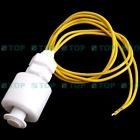I nearly had a flood in my basement due to a small leak (corroded valve) becoming not so small when I was away for Christmas. I am now thinking about a low-level water sensor using the capacitance change from a dry to a wet state. When low levels of water are detected, a relay would open and switch my well pump off.
The sensor would be a thin printed circuit board with interdigited tracks. Every other one would be connected to each other to form a low value, flat capacitor. The track side would be coated a thin layer of epoxy to seal the electrical parts from moisture and corrosion. The PICAXE and components would allso be on this board to minimize connecting cable capacitance.
There are a number of different ways to measure a small capacitance using a PICAXE; generate a high(ish) frequency ac using the PWM function, rectify and measure the resulting current; drive both capacitor terminals to ground, (known starting condition) then drive one terminal high and immediately measure the voltage on the second terminal, the higher the voltage the greater the capacitance; make a relaxation oscillator like a 555 chip and measure the period.
Any other ideas on how to do it or experience with water sensing?
The sensor would be a thin printed circuit board with interdigited tracks. Every other one would be connected to each other to form a low value, flat capacitor. The track side would be coated a thin layer of epoxy to seal the electrical parts from moisture and corrosion. The PICAXE and components would allso be on this board to minimize connecting cable capacitance.
There are a number of different ways to measure a small capacitance using a PICAXE; generate a high(ish) frequency ac using the PWM function, rectify and measure the resulting current; drive both capacitor terminals to ground, (known starting condition) then drive one terminal high and immediately measure the voltage on the second terminal, the higher the voltage the greater the capacitance; make a relaxation oscillator like a 555 chip and measure the period.
Any other ideas on how to do it or experience with water sensing?


